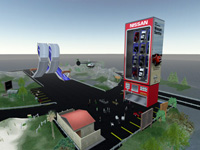 OutFront: Sex, Pranks and Reality
OutFront: Sex, Pranks and Reality
by Allison Fass
Forbes.com
July 2, 2007
Second Life’s virtual Web world can be a weird, chancy place for real-life brands.
In April a helicopter crashed into a Nissan building, starting a fire that left a couple of dead bodies. The explosion took place on Altima Island in Second Life, a Web fantasy world where users create customized, cartoonlike characters called avatars. The crash, whether an accident or an intentional prank, wasn’t exactly an image-enhancing moment for a carmaker. Nissan’s online reps cleaned up the virtual mess, coffins and all.
Marketers have flocked to Second Life since it went live in 2003. Coca-Cola, H&R Block, IBM and Toyota are among 80 companies that have set up a virtual presence there to capture eyeballs–Second Life boasts a population of 7.1 million registered users–and experiment with online branding. It’s cheap: Linden Lab, the site’s creator, charges $1,675 plus $295 a month to occupy an island. Visitors pay nothing.
But this leasehold doesn’t fence out troublemakers. It turns out that avatars seem more interested in having sex and hatching pranks than spending time warming up to real-world brands. “There is nothing to do in Second Life except, pardon my bluntness, try to get laid,” blogged David Churbuck, Web-marketing vice president for computer maker Lenovo. (Lenovo isn’t represented on Second Life.)
Earlier this year an S&M sex parlor, opened by a naughty Second Life visitor, carried the NBC Universal name. Around the same time political bloggers caught “Bush ’08”-tag-wearing vandals defacing former senator John Edwards’ Second Life headquarters with excrement and covering his photo in blackface. And there is still a twittering among online gawkers about the flying penises that interrupted a virtual interview between a CNET reporter and Anshe Chung, the Second Life name for Ailin Graef, who buys and sells Second Life real estate on the site. Such antics are called “griefing” in Second Life parlance.
“If brands go into a space like this they have to go in with their eyes open about the hazards they might have to deal with,” says Gregory Verdino, vice president of emerging channels at Digitas, an online agency.
Some marketers are disappointed that there aren’t as many people cruising the site as they’d expected. The number of residents who logged in over a recent seven-day period is 360,000. At any given time it’s more like 30,000. Starwood Hotels & Resorts considered hotel-design feedback from Second Lifers when it launched the virtual prototype of its Aloft chain last fall. (It’s adding radios to guest-room showers at Second Lifers’ suggestions.) Now focused on getting Aloft launched in the real world, Starwood plans to hand over its Second Life real estate to another user. “We need a compelling reason for people to stop by–that’s hard to keep coming up with,” says Brian McGuinness, an Aloft vice president.
American Apparel, the first retailer to set up a virtual store on the site, in June 2006, is all but shuttering its Second Life shop, which attracted more critics than shoppers. Not long after it opened, a group called the Second Life Liberation Army–its members are grumpy about commercialization on Second Life, among other things–shot American Apparel customers with virtual guns. Rasmus Schià¶nning, Web director for the company, says the retailer is disappointed by “insignificant” sales from the site.
The anything-goes nature of Second Life makes it unique, says Catherine Smith, Linden Lab’s marketing director. “If you’re worried about relinquishing a little control, then Second Life’s probably not for you,” she says. Indeed, mayhem like a helicopter crash doesn’t scare Nissan. “This is a virtual world–it’s the people who control what happens in it,” shrugs Stephen Kerho, its North America director for interactive media.
Wells Fargo stopped using Linden Lab’s clunky technology to run the financial company’s virtual Stagecoach Island (from its own Web site) four months after setting it up in September 2005. It no longer has any connection with Second Life. Laughs Erik Hauser, creative director of Swivel Media, Wells Fargo’s digital agency: “Going into Second Life now is the equivalent of running a field marketing program in Iraq.”
